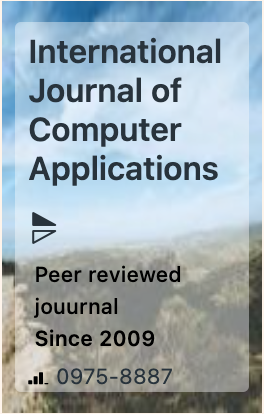The week's pick
Random Articles
Reseach Article
AI-Driven Cybersecurity: Leveraging Machine Learning Algorithms for Advanced Threat Detection and Mitigation
| International Journal of Computer Applications |
| Foundation of Computer Science (FCS), NY, USA |
| Volume 186 - Number 69 |
| Year of Publication: 2025 |
| Authors: Md. Aminur Rahman, Manjur Ahammed, Mohammad Mizanur Rahaman, Alvi Amin Khan |
 10.5120/ijca2025924526
10.5120/ijca2025924526
|
Md. Aminur Rahman, Manjur Ahammed, Mohammad Mizanur Rahaman, Alvi Amin Khan . AI-Driven Cybersecurity: Leveraging Machine Learning Algorithms for Advanced Threat Detection and Mitigation. International Journal of Computer Applications. 186, 69 ( Mar 2025), 50-60. DOI=10.5120/ijca2025924526
Abstract
The rapid evolution of cyber threats necessitates advanced solutions, and Artificial Intelligence (AI) has emerged as a transformative tool in cybersecurity. This study aims to evaluate the effectiveness of AI-driven machine learning algorithms—Convolutional Neural Networks (CNN), Artificial Neural Networks (ANN), and Support Vector Machines (SVM)—in enhancing threat detection and mitigation. Leveraging the KDD Cup 99 dataset, the research employs a rigorous experimental setup, including data preprocessing, feature selection, and algorithm evaluation using accuracy, precision, recall, F1-score, and ROC-AUC metrics. The results reveal that CNN outperformed other models, achieving a 96.5% accuracy and demonstrating superior capability in identifying complex attack patterns. ANN and SVM also performed well, with accuracies of 94.8% and 92.1%, respectively. These findings underscore the potential of AI to bolster cybersecurity frameworks, offering improved detection rates and reduced false positives. The study contributes to the growing field of AI-driven cybersecurity by providing actionable insights for integrating machine learning models into practical applications. Future research is encouraged to explore hybrid models, real-time threat intelligence, and broader datasets to further enhance the adaptability and efficacy of AI-driven solutions in combating the dynamic landscape of cyber threats.
References
- Roshanaei, M., Khan, M. R., & Sylvester, N. N. (2024). Navigating AI cybersecurity: evolving landscape and challenges. Journal of Intelligent Learning Systems and Applications, 16(3), 155-174.
- Jimmy, F. (2021). Emerging threats: The latest cybersecurity risks and the role of artificial intelligence in enhancing cybersecurity defenses. Valley International Journal Digital Library, 564-574.
- Camacho, N. G. (2024). The Role of AI in Cybersecurity: Addressing Threats in the Digital Age. Journal of Artificial Intelligence General science (JAIGS) ISSN: 3006-4023, 3(1), 143-154.
- Malatji, M., & Tolah, A. (2024). Artificial intelligence (AI) cybersecurity dimensions: a comprehensive framework for understanding adversarial and offensive AI. AI and Ethics, 1-28.
- Babu, C. S. (2024). Adaptive AI for Dynamic Cybersecurity Systems: Enhancing Protection in a Rapidly Evolving Digital Landscap. In Principles and Applications of Adaptive Artificial Intelligence (pp. 52-72). IGI Global.
- Abrahams, T. O., Ewuga, S. K., Dawodu, S. O., Adegbite, A. O., & Hassan, A. O. (2024). A review of cybersecurity strategies in modern organizations: examining the evolution and effectiveness of cybersecurity measures for data protection. Computer Science & IT Research Journal, 5(1), 1-25.
- Roshanaei, M., Khan, M. R., & Sylvester, N. N. (2024). Enhancing cybersecurity through AI and ML: Strategies, challenges, and future directions. Journal of Information Security, 15(3), 320-339.
- Yaseen, A. (2023). AI-driven threat detection and response: A paradigm shift in cybersecurity. International Journal of Information and Cybersecurity, 7(12), 25-43.
- George, A. S. (2024). Emerging Trends in AI-Driven Cybersecurity: An In-Depth Analysis. Partners Universal Innovative Research Publication, 2(4), 15-28.
- Albahri, O. S., & AlAmoodi, A. H. (2023). Cybersecurity and Artificial Intelligence Applications: A Bibliometric Analysis Based on Scopus Database. Mesopotamian Journal of CyberSecurity, 2023, 158-169.
- Zaid, T., & Garai, S. (2024). Emerging Trends in Cybersecurity: A Holistic View on Current Threats, Assessing Solutions, and Pioneering New Frontiers. Blockchain in Healthcare Today, 7.
- Hussain, S. M., Tummalapalli, S. R. K., & Chakravarthy, A. S. N. (2024). Cyber Security Education: Enhancing Cyber Security Capabilities, Navigating Trends and Challenges in a Dynamic Landscape. Advances in Cyber Security and Digital Forensics, 9-33.
- Akinsanya, M. O., Ekechi, C. C., & Okeke, C. D. (2024). The evolution of cyber resilience frameworks in network security: a conceptual analysis. Computer Science & IT Research Journal, 5(4), 926-949.
- Khaleel, Y. L., Habeeb, M. A., Albahri, A. S., Al-Quraishi, T., Albahri, O. S., & Alamoodi, A. H. (2024). Network and cybersecurity applications of defense in adversarial attacks: A state-of-the-art using machine learning and deep learning methods. Journal of Intelligent Systems, 33(1), 20240153.
- Macas, M., Wu, C., & Fuertes, W. (2022). A survey on deep learning for cybersecurity: Progress, challenges, and opportunities. Computer Networks, 212, 109032.
- Srivastava, G., Jhaveri, R. H., Bhattacharya, S., Pandya, S., Maddikunta, P. K. R., Yenduri, G., ... & Gadekallu, T. R. (2022). XAI for cybersecurity: state of the art, challenges, open issues and future directions. arXiv preprint arXiv:2206.03585.
- George, A. S. (2024). Emerging Trends in AI-Driven Cybersecurity: An In-Depth Analysis. Partners Universal Innovative Research Publication, 2(4), 15-28.
- Balantrapu, S. S. (2024). Current Trends and Future Directions Exploring Machine Learning Techniques for Cyber Threat Detection. International Journal of Sustainable Development Through AI, ML and IoT, 3(2), 1-15.
- Mahdavifar, S., & Ghorbani, A. A. (2019). Application of deep learning to cybersecurity: A survey. Neurocomputing, 347, 149-176.
- Dasgupta, D., Akhtar, Z., & Sen, S. (2022). Machine learning in cybersecurity: a comprehensive survey. The Journal of Defense Modeling and Simulation, 19(1), 57-106.
- Kaur, R., Gabrijelčič, D., & Klobučar, T. (2023). Artificial intelligence for cybersecurity: Literature review and future research directions. Information Fusion, 97, 101804.
- Wu, Y., Ge, J., & Li, T. (2022). AI and Machine Learning for Network and Security Management. John Wiley & Sons.
- Kaja, N. (2019). Artificial intelligence and cybersecurity: Building an automotive cybersecurity framework using machine learning algorithms (Doctoral dissertation).
- Hwang, S. Y., Shin, D. J., & Kim, J. J. (2022). Systematic review on identification and prediction of deep learning-based cyber security technology and convergence fields. Symmetry, 14(4), 683.
- Sarker, I. H. (2023). Multi‐aspects AI‐based modeling and adversarial learning for cybersecurity intelligence and robustness: A comprehensive overview. Security and Privacy, 6(5), e295.
- Mamidi, S. R. (2024). Future Trends in AI Driven Cyber Security. IRE Journal, August.
- Liu, R., Shi, J., Chen, X., & Lu, C. (2024). Network anomaly detection and security defense technology based on machine learning: A review. Computers and Electrical Engineering, 119, 109581.
- Balantrapu, S. S. (2024). Current Trends and Future Directions Exploring Machine Learning Techniques for Cyber Threat Detection. International Journal of Sustainable Development Through AI, ML and IoT, 3(2), 1-15.
- Sewak, M., Sahay, S. K., & Rathore, H. (2023). Deep reinforcement learning in the advanced cybersecurity threat detection and protection. Information Systems Frontiers, 25(2), 589-611.
- Dasgupta, D., Akhtar, Z., & Sen, S. (2022). Machine learning in cybersecurity: a comprehensive survey. The Journal of Defense Modeling and Simulation, 19(1), 57-106.
- Mustafa, Z., Amin, R., Aldabbas, H., & Ahmed, N. (2024). Intrusion detection systems for software-defined networks: a comprehensive study on machine learning-based techniques. Cluster Computing, 1-27.
- Kikissagbe, B. R., & Adda, M. (2024). Machine Learning-Based Intrusion Detection Methods in IoT Systems: A Comprehensive Review. Electronics, 13(18), 3601.
- Vegesna, V. V. (2024). Machine Learning Approaches for Anomaly Detection in Cyber-Physical Systems: A Case Study in Critical Infrastructure Protection. International Journal of Machine Learning and Artificial Intelligence, 5(5), 1-13.
- Kassem, A. K. (2021). Intelligent system using machine learning techniques for security assessment and cyber intrusion detection (Doctoral dissertation, Université d'Angers).
- Ahsan, M., Nygard, K. E., Gomes, R., Chowdhury, M. M., Rifat, N., & Connolly, J. F. (2022). Cybersecurity threats and their mitigation approaches using Machine Learning—A Review. Journal of Cybersecurity and Privacy, 2(3), 527-555.
- Abdul, S. AI for Cyber Security: Automated Incident Response Systems.
- Oko-Odion, C. Forecasting Techniques in Predictive Analytics: Leveraging Database Management for Scalability and Real-Time Insights.
- Ullah, H., Uzair, M., Jan, Z., & Ullah, M. (2024). Integrating industry 4.0 technologies in defense manufacturing: Challenges, solutions, and potential opportunities. Array, 100358.
- Chukwu, N., Yufenyuy, S., Ejiofor, E., Ekweli, D., Ogunleye, O., Clement, T., ... & Obunadike10, C. (2024). Resilient Chain: AI-Enhanced Supply Chain Security and Efficiency Integration. Int. J. Sci. Manag. Res, 7(03), 46-65.
- Goel, P. K., Pandey, H. M., Singhal, A., & Agarwal, S. (Eds.). (2024). Analyzing and Mitigating Security Risks in Cloud Computing. IGI Global.
- Riesco Granadino, R. (2019). Contribution to dynamic risk management automation by an ontology-based framework (Doctoral dissertation, Telecomunicacion).
- Alvarez-Alvarado, M. S., Apolo-Tinoco, C., Ramirez-Prado, M. J., Alban-Chacón, F. E., Pico, N., Aviles-Cedeno, J., ... & Rengifo, J. (2024). Cyber-physical power systems: A comprehensive review about technologies drivers, standards, and future perspectives. Computers and Electrical Engineering, 116, 109149.
- Alonso, R., Haber, R. E., Castaño, F., & Recupero, D. R. (2024). Interoperable software platforms for introducing artificial intelligence components in manufacturing: A meta-framework for security and privacy. Heliyon, 10(4).
Index Terms
Keywords

